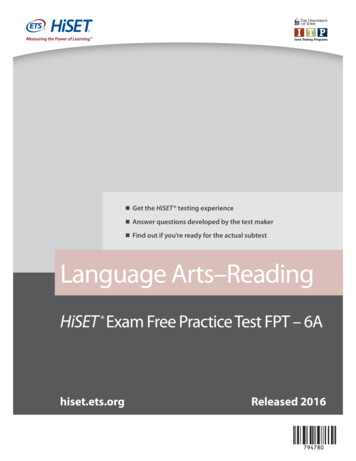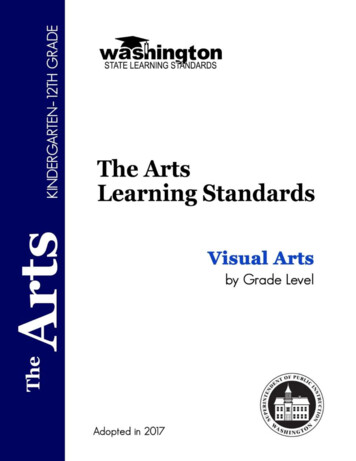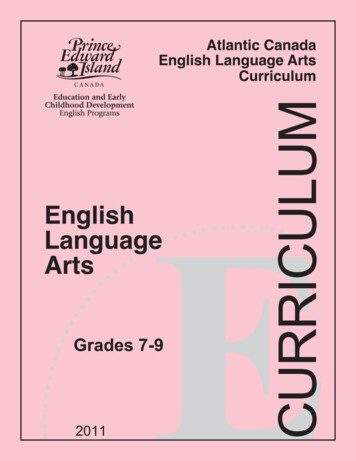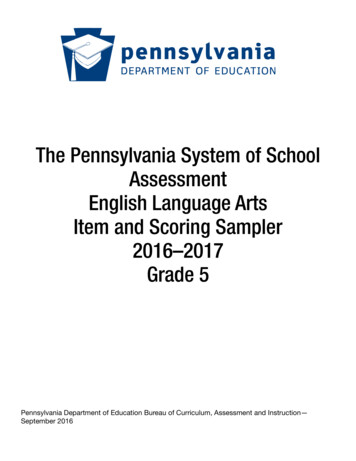
Transcription
Get the HiSET testing experience Answer questions developed by the test maker Find out if you’re ready for the actual subtestLanguage Arts–ReadingHiSET Exam Free Pracacticticee Test FPT – 6Ahiset.ets.orgReleased 2016
Copyright 2016 by Educational Testing Service. All rights reserved. ETS, the ETS logo and HiSET are registeredtrademarks of Educational Testing Service (ETS). MEASURING THE POWER OF LEARNING is a trademark ofETS. Test items copyright 2001, 2003, 2007 by The University of Iowa. All rights reserved. Used under license fromHoughton Mifflin Harcourt. THE IOWA TESTS is a registered trademark of Houghton Mifflin Harcourt PublishingCompany. Test items from Iowa Testing Programs copyright 2016 by The University of Iowa. All rights reserved.
Language Arts – ReadingDirectionsTime 35 minutes20 QuestionsThis is a test of some of the skills involved in understanding what you read. The passages in this testcome from a variety of works, both literary and informational. Each passage is followed by a numberof questions.The passages begin with an introduction presenting information that may be helpful as you read theselection. After you have read a passage, go on to the questions that follow. For each question, choosethe best answer, and mark your choice on the answer sheet. You may refer to a passage as often asnecessary.Work as quickly as you can without becoming careless. Do not spend too much time on any questionthat is difficult for you to answer. Instead, skip it and return to it later if you have time. Try to answerevery question even if you have to guess.Mark all your answers on the answer sheet. Give only one answer to each question.If you decide to change one of your answers, be sure to erase the first mark completely.Be sure that the number of the question you are answering matches the number of the row of answerchoices you are marking on your answer sheet. The answer sheet may contain more rows than youneed.
Questions 1 – 6 refer to the following passage.The next two passages are related. First you will read one passage and answer questions. Then you willread another passage and answer questions. Then you will answer questions related to both passages.Excerpt from “Do We Still Need Skyscrapers?”Line5101520253035Our distant forebears could create remarkably tall structures by exploiting the compressive strength of stoneand brick, but the masonry piles they constructed in this way contained little usable interior space.At 146 meters (480 feet), the Great Pyramid of Cheops is a vivid expression of the ruler’s power, but insideit is mostly solid rock.The Industrial Revolution eventually provided ways to open up the interiors of tall towers and put largenumbers of people inside. Nineteenth-century architects found that they could achieve greatly improved ratiosof open floor area to solid construction by using steel and reinforced concrete framing and thin curtain walls.And they could integrate increasingly sophisticated mechanical systems to heat, ventilate, and cool growingamounts of interior space. In the 1870s and 1880s, visionary New York and Chicago architects and engineersbrought these elements together to produce the modern skyscraper.These newfangled architectural contraptions found a ready market because they satisfied industrialcapitalism’s growing need to bring armies of office workers together at locations where they couldconveniently interact with one another, gain access to files and other work materials, and be supervised bytheir bosses. Furthermore, tall buildings fitted perfectly into the emerging pattern of the commuter city, withits high-density central business district, ring of low-density bedroom suburbs, and radial transportationsystems for the daily return journey. This centralization drove up property values in the urban core andcreated a strong economic motivation to jam as much floor area as possible onto every available lot. So as thetwentieth century unfolded, and cities such as New York and Chicago grew, downtown skylines sproutedhigher while the suburbs spread wider.But there were natural limits to this upward extension of skyscrapers. The higher you go, the more of thefloor area must be occupied by structural supports. At some point, it becomes uneconomical to add additionalfloors; the diminishing increment of usable floor area does not justify the increasing increment of cost.Urban planning and design considerations constrain height as well. Tall buildings have some unwelcomeeffects at ground level; they cast long shadows, blot out the sky, and sometimes create dangerous andunpleasant blasts of wind. And they generate pedestrian and automobile traffic that strains the capacity ofsurrounding streets. To control these effects, planning authorities typically impose limits on height and on theratio of floor area to ground area.The consequence of these various limits is that exceptionally tall buildings have always been expensive, rare,and conspicuous. So organizations can effectively draw attention to themselves and express their power andprestige by finding ways to construct the loftiest skyscrapers in town, in the nation, or maybe even in theworld.While this race has been running, though, the burgeoning Digital Revolution has been reducing the need tobring office workers together, face-to-face, in expensive downtown locations. Efficient telecommunicationshave diminished the importance of centrality and correspondingly increased the attractiveness of lessexpensive suburban sites that are more convenient to the labor force. Digital storage and computer networkshave increasingly supported decentralized remote access to databases rather than reliance on centralized paperfiles. And businesses are discovering that their marketing and public-relations purposes may now be betterserved by slick World Wide Web pages on the Internet and Super Bowl advertising spots than by investmentsin monumental architecture on expensive urban sites.Do We Still Need Skyscrapers? By William J. Mitchell. Scientific American, December 1997The third party trademark SUPER BOWL was used in these testing materials.Unauthorized copying or reuse of any part of this page is illegal.4GO O N
The passage suggests that an important factor inmaking skyscrapers possible in the late 1800swasA. innovation in mathematical formulas.B. better understanding of the compressivestrength of stone and brick.C. the availability of improved constructionmaterials and methods.D. the fact that large numbers of people wereliving in cities.2The passage indicates that after a certain point,as the height of a building increases, usable floorspace in additional storiesA. increases.B. decreases.C. needs fewer supports.D. is relatively inexpensive.3What is the meaning of “burgeoning” (line 32)?A. GrowingB. IntriguingC. InfluentialD. UnexpectedUnauthorized copying or reuse of any part of this page is illegal.154What does the author view as the primary reasonthat skyscrapers are in less demand than theyonce were?A. Workers are increasingly unwilling tocommute downtown.B. People are not as impressed by skyscrapersas they used to be.C. Communications technology now allowsemployees to work from any location.D. Relatively inexpensive land is now availablein the suburbs.5According to the passage, why have skyscrapersbecome less effective advertising tools than theyused to be?A. Companies cannot afford to buildskyscrapers anymore.B. Skyscrapers are no longer symbols of wealthand power.C. It is not feasible to build anything taller thanexisting skyscrapers.D. Skyscrapers have less influence on peoplethan TV and the Internet now do.6Which of the following best summarizes thegeneral point the author makes in the lastparagraph?A. The Internet has become an increasinglypopular tool among businesses.B. Businesses should reevaluate theiradvertising strategies.C. Many of the needs skyscrapers once fulfilledfor businesses are now being met by newtechnology.D. Businesses are no longer willing to constructenormous buildings on expensive city lots.GO O N
Questions 7 and 8 refer to the following passage.Pencil TowersLine5101520Some newer buildings in New York City are remarkable not just for their height but also for theirwidth — or lack thereof. Known as “skinnyscrapers,” or “pencil towers,” these buildings, already common inthe crowded city of Hong Kong, are redefining Manhattan’s skyline with their thin profiles and dizzyingaltitudes.The tallest pencil towers soar over 90 stories high but have a much smaller footprint than traditionalskyscrapers, which stand wide at street level but narrow as they rise upward. Pencil towers are primarilyresidential and do not need to support thousands of workers pouring in and out each day. Because of this,pencil towers can be built with fewer elevator banks, more compact floor plans, and less complex systems forplumbing, heating, and cooling. Shrinking these features allows architects to reduce the buildings’ interiorspace requirements and simply build up, not out and around. This makes pencil towers a more attractivechoice for developers when building where land is very expensive. These more slimly designed skyscrapersalso cast thinner shadows and block less of the sun than their predecessors.Pencil towers certainly have their critics, however. Many New Yorkers worry about the aesthetic impact ofthe buildings’ modern architecture and excessive height on the landscape of historic neighborhoods. The priceof the pencil towers’ luxury residences has caused resentment as well. For example, apartments in the96-story high-rise named 432 Park Avenue are among the most expensive in the world, selling for tens ofmillions of dollars. These homes are not accessible to most locals but are marketed mostly to the global ultrarich, who may live in New York for only a few weeks a year. Regardless, because these new skyscrapers canoffer panoramic views in prime locations, the tall, slender spires will likely keep rising above the skylines ofmajor world cities for years to come.Unauthorized copying or reuse of any part of this page is illegal.6GO O N
Which building feature would most likely beincluded in the design of a pencil tower butwould NOT be included in a traditionalskyscraper?A. ElevatorB. Swimming poolC. LobbyD. Air conditioning system8The last paragraph of the passage implies thatsome local residents see the pencil towers assymbols ofA. economic growth.B. architectural creativity.C. financial inequality.D. environmental neglect.Unauthorized copying or reuse of any part of this page is illegal.779Use both the excerpt from “Do We Still NeedSkyscrapers?” and “Pencil Towers” to answerthis question.Which statement best represents a main ideafound in both passages?A. There are structural limitations that restricthow high skyscrapers can reach.B. The cost associated with constructing tallbuildings constantly increases.C. Skyscrapers are designed around the needs oftheir intended tenants.D. Newer building methods are superior to olderconstruction techniques.10Use both the excerpt from “Do We Still NeedSkyscrapers?” and “Pencil Towers” to answerthis question.Why would pencil towers likely experience lessof the increased pedestrian and automobile trafficthat occurs around traditional skyscrapers?A. Pencil towers have fewer occupants.B. Pencil towers have less historical value.C. Pencil towers are located in less-populatedareas.D. Pencil towers have more entrances and exits.GO O N
Questions 11 – 15 refer to the following poem.The following poem was written by Martín Espada.Who Burns for the Perfection of PaperLine510152025At sixteen, I worked after high school hoursat a printing plantthat manufactured legal pads:Yellow paperstacked seven feet highand leaningas I slipped cardboardbetween the pages,then brushed red glueup and down the stack.No gloves: fingertips requiredfor the perfection of paper,smoothing the exact rectangle.Sluggish by 9 P.M., the handswould slide along suddenly sharp paper,and gather slits thinner than the crevicesof the skin, hidden.Then the glue would sting,hands oozingtill both palms burnedat the punchclock.Ten years later, in law school,I knew that every legal padwas glued with the sting of hidden cuts,that every open lawbookwas a pair of handsupturned and burning.Courtesy of Martín EspadaIn lines 1-21, the speaker in the poem isprimarily describingA. his current job.B. a job he had as a teenager.C. the challenges he faced in high school.D. the process of bookbinding.Unauthorized copying or reuse of any part of this page is illegal.11812The work the poem describes apparently requiresA. speed.B. precision.C. accurate timing.D. technical training.GO O N
Which of the following is NOT among thethemes this poem addresses?A. The little-known ordeals involved in thecreation of ordinary objectsB. The acknowledgment of the dignity of allkinds of workC. The contrast between the speaker’srelationship to legal pads as a factory workerand as a law studentD. The toll that after-school jobs take on theacademic achievement of high-schoolstudents14Which of these does the speaker most stronglyexpress at the end of the poem (lines 22-27)?A. Recognition of what workers have had toundergo to produce the articles he uses in hisprofessionB. Regret that he has chosen a career thatentails the use of legal padsC. Resentment about the working conditions heonce had to bearD. Relief that he can now take legal pads forgranted rather than suffer through the processof making themUnauthorized copying or reuse of any part of this page is illegal.13915In the last three lines, the comparison of an openlawbook to a pair of hands “upturned andburning” can be seen as suggesting all of thefollowing ideas EXCEPTA. a passion for justice.B. the hope that a system of laws can offer.C. a gesture of resignation or giving up.D. the physical hardships endured by productionworkers.GO O N
Questions 16 – 20 refer to the following passage.In this adaptation from the opening of a historical novel by Henry Carlisle, a seventeen-year-old boy isreturning from his first voyage on a whaling ship after nineteen months at sea.Excerpt from The Jonah ManI was on board the Eliza Slade, returning to the Island on a blue, windy September afternoon in 1808; we hadrounded Brant Point and the town came into view.Line5That day was a proud one for me. Not two hours before, Mr. Bench, the mate of the Slade, standing withCaptain Clasby on the afterdeck, had called me over to them and the captain had growled, “Well, Pollard, Iguess it’s back to the potato patch for you now. Eh?”“No, sir,” I said.“No, sir?” he said in mock surprise.“I intend to ship on another whaling cruise.”“Ship again! Did you hear what this young man just said, Mr. Bench?”10“Truly amazing.”The captain shook his head in wonderment. “You mean to tell me, Pollard, that with all the trouble thewhales have given you, not to mention Mr. Bench, that you actually want to go whaling again?”“Yes, sir. I mean to spend my life at it.”“Worse than I thought,” said Clasby. “Much worse.”15“Hopeless, I’d say,” said Mr. Bench.Then the captain eyed me narrowly and said, “Well, then, in that case I guess I got no choice but torecommend you for boatsteerer your next voyage out. ’Course the say-so’ll be your next skipper’s and theowner’s, but they’ll have my view of the matter, and you can use it as you like.”“Thank you, sir,” I told him. “Thank you very much.”20Captain Clasby studied me for a moment, then, still looking at me, said to the mate, “Reckon he’ll alwaysthink I’ve done him such a favor, Mr. Bench?”At the time the captain’s question made no sense to me. As we neared our anchorage my gaze swept thetown. I felt elated on this first homecoming, assured that I had acquitted myself creditably, and all that Icould see ahead on that bright September afternoon was clear sailing.25My Uncle Hezekiah met me at the wharf, the news of the arrival of the Eliza Slade having not yet reachedmy family in Polpis, six miles upharbor from the town.“How’s everyone in Polpis?”“Same. ’Bout the same. How long you been out?”“Nineteen months.”30“Be shipping again?”“Yes, sir.”“Your old man could use you handily on the farm.”“Can’t help that.”Unauthorized copying or reuse of any part of this page is illegal.10GO O N
35My uncle was right about the farm at Polpis. Everything was about the same there. Sheep bells tinkled.Chickens squawked. My mother greeted me as a ghost returned from the dead. My father was pleased to seeme. My safe return had settled an argument in his favor.“See, Tamar,” he said that evening, poking at the fire in the kitchen hearth. “He’s home in one piece. Whatabout all them gloomy predictions?”40As if she hadn’t heard him, my mother looked at me and said, “Glad you’re home, son, and hope you’ll stayawhile. We need you here.”My younger sister, Susan, was looking at me expectantly. I reached into my pocket and handed her apackage. With delight she opened it and took out the amber necklace I had bought her in Valparaiso.“It’s pretty,” she said and kissed me on the cheek.“Pearls next time,” I told her.45My mother looked at my father. “Next time,” she said.In the days that followed I helped with the last of the harvest, feeling that everyone was blind to the changesthat had happened in me. They were still treating me as the Polpis farm boy I had been before I put to sea.Everything was the same except me.Excerpts from The Jonah Man 1984 by Henry C. Carlisle. Used by permission of the Hill Nadell Literary AgencyWhat is the major source of young Pollard’sfeeling of pride on the day the Eliza Sladereturned to port?A. Seeing the family farm at Polpis in thedistanceB. The sight of his hometown after nineteenmonths awayC. Relief that he had been able to survive thelong, perilous voyageD. Learning that he had earned arecommendation for promotionUnauthorized copying or reuse of any part of this page is illegal.161117The exchange between Captain Clasbyand Mr. Bench in lines 9-15 primarily reflectsA. serious concern for a young man’s welfare.B. good-humored teasing of a young sailor.C. the sarcastic scorn of sailors for a farm boy.D. mean-spirited ridicule of an inexperiencedshipmate.GO O N
This passage is reprinted here for your convenience in answering questions 18 – 20.In this adaptation from the opening of a historical novel by Henry Carlisle, a seventeen-year-old boy isreturning from his first voyage on a whaling ship after nineteen months at sea.Excerpt from The Jonah ManI was on board the Eliza Slade, returning to the Island on a blue, windy September afternoon in 1808; we hadrounded Brant Point and the town came into view.Line5That day was a proud one for me. Not two hours before, Mr. Bench, the mate of the Slade, standing withCaptain Clasby on the afterdeck, had called me over to them and the captain had growled, “Well, Pollard, Iguess it’s back to the potato patch for you now. Eh?”“No, sir,” I said.“No, sir?” he said in mock surprise.“I intend to ship on another whaling cruise.”“Ship again! Did you hear what this young man just said, Mr. Bench?”10“Truly amazing.”The captain shook his head in wonderment. “You mean to tell me, Pollard, that with all the trouble thewhales have given you, not to mention Mr. Bench, that you actually want to go whaling again?”“Yes, sir. I mean to spend my life at it.”“Worse than I thought,” said Clasby. “Much worse.”15“Hopeless, I’d say,” said Mr. Bench.Then the captain eyed me narrowly and said, “Well, then, in that case I guess I got no choice but torecommend you for boatsteerer your next voyage out. ’Course the say-so’ll be your next skipper’s and theowner’s, but they’ll have my view of the matter, and you can use it as you like.”“Thank you, sir,” I told him. “Thank you very much.”20Captain Clasby studied me for a moment, then, still looking at me, said to the mate, “Reckon he’ll alwaysthink I’ve done him such a favor, Mr. Bench?”At the time the captain’s question made no sense to me. As we neared our anchorage my gaze swept thetown. I felt elated on this first homecoming, assured that I had acquitted myself creditably, and all that Icould see ahead on that bright September afternoon was clear sailing.25My Uncle Hezekiah met me at the wharf, the news of the arrival of the Eliza Slade having not yet reachedmy family in Polpis, six miles upharbor from the town.“How’s everyone in Polpis?”“Same. ’Bout the same. How long you been out?”“Nineteen months.”30“Be shipping again?”“Yes, sir.”“Your old man could use you handily on the farm.”“Can’t help that.”Unauthorized copying or reuse of any part of this page is illegal.12GO O N
35My uncle was right about the farm at Polpis. Everything was about the same there. Sheep bells tinkled.Chickens squawked. My mother greeted me as a ghost returned from the dead. My father was pleased to seeme. My safe return had settled an argument in his favor.“See, Tamar,” he said that evening, poking at the fire in the kitchen hearth. “He’s home in one piece. Whatabout all them gloomy predictions?”40As if she hadn’t heard him, my mother looked at me and said, “Glad you’re home, son, and hope you’ll stayawhile. We need you here.”My younger sister, Susan, was looking at me expectantly. I reached into my pocket and handed her apackage. With delight she opened it and took out the amber necklace I had bought her in Valparaiso.“It’s pretty,” she said and kissed me on the cheek.“Pearls next time,” I told her.45My mother looked at my father. “Next time,” she said.In the days that followed I helped with the last of the harvest, feeling that everyone was blind to the changesthat had happened in me. They were still treating me as the Polpis farm boy I had been before I put to sea.Everything was the same except me.Excerpts from The Jonah Man 1984 by Henry C. Carlisle. Used by permission of the Hill Nadell Literary AgencyCaptain Clasby’s question in lines 20-21 seemsto hint that later in the storyA. the plot will be primarily a humorous one.B. a dark side to Clasby’s character will berevealed.C. Pollard will probably face tougher challengesat sea than he can imagine.D. the symbolic differences between life on landand at sea will be a main theme.19Which of these best describes howCaptain Clasby is portrayed in this passage?A. Gruff but kindB. Competent but insensitiveC. Casual and irresponsibleD. Humorless and strictUnauthorized copying or reuse of any part of this page is illegal.181320Pollard’s mother had apparently predicted that hewouldA. not survive his voyage.B. not come home for a visit.C. not want to work the farm.D. return home empty-handed.
Answer KeySequenceNumberCorrectResponseProcess CategoryQuestionDifficulty1CD. Synthesis and GeneralizationMedium2BA. ComprehensionMedium3AA. ComprehensionMedium4CC. AnalysisMedium5DA. ComprehensionMedium6CC. AnalysisMedium7BB. Inference and InterpretationMedium8CB. Inference and InterpretationMedium9CD. Synthesis and GeneralizationMedium10AD. Synthesis and GeneralizationMedium11BC. AnalysisEasy12BB. Inference and InterpretationMedium13DC. AnalysisMedium14AD. Synthesis and GeneralizationMedium15CC. AnalysisMedium16DB. Inference and InterpretationMedium17BC. AnalysisMedium18CB. Inference and InterpretationMedium19AB. Inference and InterpretationMedium20AB. Inference and InterpretationMediumUnauthorized copying or reuse of any part of this page is illegal.14
15
hiset.ets.org Released 2016 HiSETHiSET Exam FExam Frree Pee Prracactictice e TTest FPT – 6Aest FPT – 6A Language Arts–Reading Get the HiSET testing experience Answer questions developed by the test










